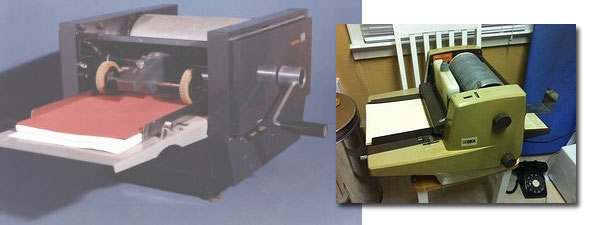
Agh the smell of the spirit, the beating click click click of the drum as you turned it, the remnant of wax on your fingers … I come to pay homage to the old Banda machine (as we called it in England). Invented in 1923 and basically not developing much since, destined to be put out to pasture courtesy of the photocopier machine, the good old rolio (as it was called in Australia?) or “ditto” (US) was a feature of pre 1990s schools, churches and libraries, where earnest professionals copied off class room lots of purple typefaced handouts. The printing faded over time, but you could get creative by applying different coloured wax backings – great for Maths or Economics charts or diagrams – and if you kept the originals carefully enough, you could print off more the next time (although they were never quite as good the second or third time around).
I remember coming across this amazing contraption in my first year of teaching, 1986, in a government school in Hertfordshire. It took some getting used to, but you could get the waxed backed paper into a typewriter (agh remember them?!) or carefully write on them (no mistakes allowed, nothing could be erased once the impression on the waxed backing had been made), before carefully inserting the paper into the Banda (get it the right way round, and make sure you have enough of the backed paper in the open slit but not too much) and carefully rolling the drum to produce your copies. Slow, steady rolls, not too fast as the paper would dislodge, too slow and you’d impart too much spirit and splotch your production. The paper often scrunched, your waxed back original could rip, the alcoholic spirit might be too less or too much … this was an art not a science. The cries of anguish could be heard in the main staff room and probably down the hallowed halls. But my departmental budget did not run into photocopying (easier, no original production required, but only black and white), so it was off to the Banda machine to create my handouts.
While I don’t want for those pre-Internet times again, there was something wonderfully Heath Robinson about the Banda, and creative about what you could do with it. And the smell – oh yes.



Ah yes the “ditto” machine……….was how we made all of our copies way back when I first began my teaching career. I’d have purple fingers the rest of the day!!
[…] with my Banda copies, I would march into 5B business class looking ever so confident with my pre-prepared over […]
I used one of these back in the late 60’s working for The South Durham Steel & Iron Co. in Hartlepool. As I remember there were several colours including black, blue green and red. I used to experiment by using 2 or 3 colours to create something different, not always successful but as a teenager it was an “adventure”. The spirit was used as a fuel to save on matches! A small circular pipe tobacco tin had the lid pierced with a small hole and a inch long length of string inserted, the base was then filled with “Banda fluid” and lit, it lasted all night shift!
Hello there, I just bought one of those old machines, and I do remember using them about 25 years ago attending elementary school in Germany. As I was quite young back then, I basically remember rolling – and the smell of course! Do you know which fluid I have to get and where to apply it?
I already bought the special paper to create the “master” together with the machine.
seem to remember in Australia is was a “roneo” machine. memories of handouts and school and guides.
[…] media. My most viewed post though was a nostalgic look at ‘lost technology’ and the old banda machine – remember those? As a teacher, I became quite adept at using the things. Visitors to my blog […]
[…] given that the book was published at a time when the smell of methylated spirits from the Banda machine filled staff rooms, the Apple II+ was released, and the first microcomputer hard drive (5MB!) was […]
[…] looking for a picture to show me what they might have looked like I came across this blog by Charlie Gunningham describes this piece of […]
[…] Many years ago, obviously channelling my inner Bard, I wrote in longhand, with a fountain pen. Pretentious? Moi? I’m surprised I didn’t use a quill. When I got over myself, I progressed to biros and then gel pens. But my writing didn’t actually ignite until I invested in a word processor. Yes, it was that long ago. Remember those bulky electronic items? Designed to be portable, weighed a ton. Successor of the typewriter, precursor of the PC, they had a brief moment in the sun, inhabiting a no man’s land between must-have utility and total obsolescence. They were equivalent in some ways to the Kindle, in that their only function was to facilitate the act of writing. You can’t watch movies on it, or access the internet, which, in retrospect, was actually a very useful feature for an aspiring writer prone to making the most of every diversionary tactic.Did I say I was easily distracted? In those days I saved my embryonic scribblings onto floppy discs, where, incidentally, they are destined to remain because my current machine hasn’t heard of these antediluvian devices. But I retain a nostalgic affection for these rectangular bits of plastic. They illustrate how far we’ve progressed, in a relatively short space of time, from carbon copies, correction fluid (remember Tippex?) and card indexes. I still use a proper address book (I skipped the Filofax generation) but I’ve traded in the Dictaphone for the recording function on my smartphone. I keep a stock of pencils (and a sharpener, obvs) and notebooks in the drawer, just in case, and as my printer will also scan and photocopy, sadly there’s no need for the much missed Banda machine […]
Oh nostalgia. Wonderful machines!
I have also faced the same problem with my canon copier. I tried a lot but no one solved this problem. You have provide detailed information about this. Thanks for helping me.
The wax-stencil one was an Anglo-American IBM Roneo-Vickers or a German-made Gestetner, not a Banda. A Banda machine took a stencil made by writing (or typing) on a sheet of plain unwaxed A4 paper which you pressed up against a Banda stencil — which was similar to carbon-paper used to make duplicates but used face-up, not face-down. Banda stencils were paper with a thick purple ink backing on the obverse. The clear spirit Banda fluid gradually dissolved the purple stencil impression and transferred it on to the plain A4 paper which fed into the machine and was squeezed under the rollers.
What I would like to know is how to get hold of one again. They are low tech, cheap to run and reliable. Where are they now? I used them between 1981 and 1991.
I do remember the smell very well. Good times.
I still use a Banda 15 at school for running off handouts, it is a lot cheaper to run than a photocopier and the thermal transfer sheets and hand written sheets are still widely available as they are now used by tattoo artists, the fluid is just a 50/50 mix of meths and isopropanol.